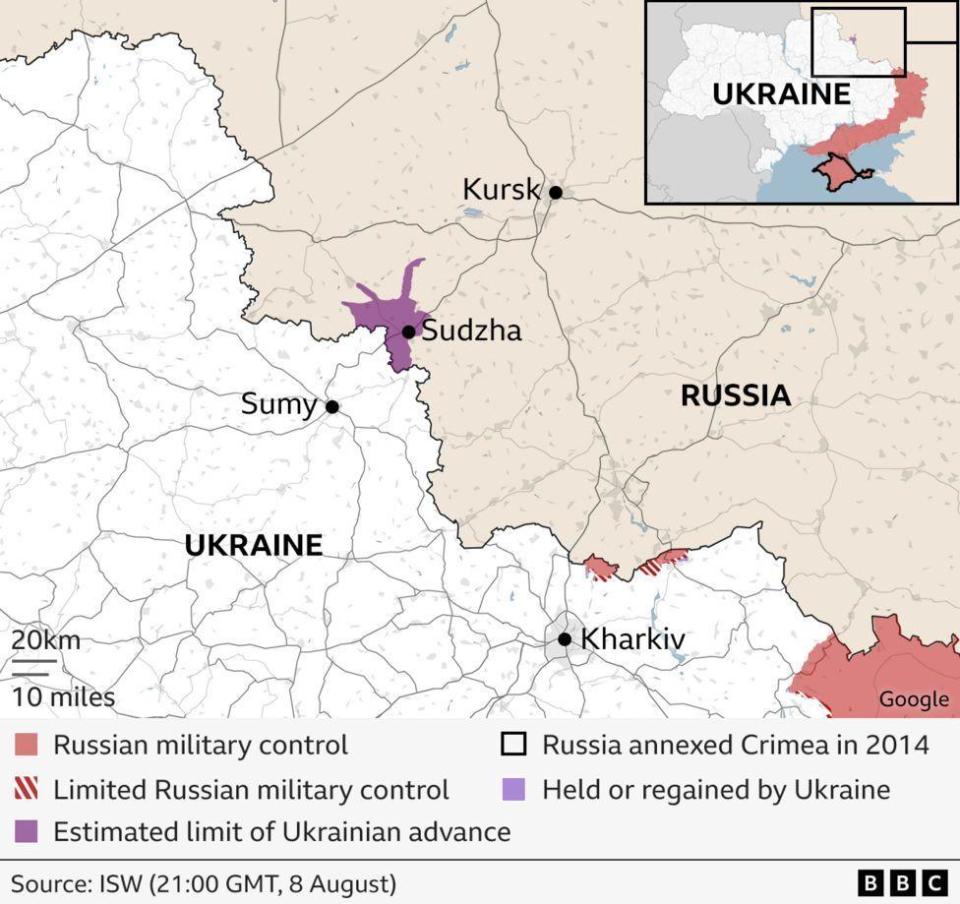Ukrainian troops have advanced up to 30km inside Russia, in what has become the deepest and most significant incursion since Moscow began its full-scale invasion of Ukraine in February 2022.
Russia’s defence ministry said its forces had engaged Ukrainian troops near the villages of Tolpino and Obshchy Kolodez, as the offensive in the Kursk region entered a sixth day.
Foreign ministry spokesperson Maria Zakharova accused Kyiv of “intimidating the peaceful population of Russia”.
President Volodymyr Zelensky, who directly acknowledged the attack for the first time in an address last night, said 2,000 cross-border attacks had been launched by Russia from Kursk this summer.
“Artillery, mortars, drones. We also record missile strikes, and each such strike deserves a fair response,” Mr Zelensky told the country in his nightly address from Kyiv.
A senior Ukrainian official told the AFP news agency that thousands of troops were engaged in the operation, far more than the small incursion initially reported by Russian border guards.
While Ukrainian-backed sabotage groups have launched intermittent cross-border incursions, the Kursk offensive marks the biggest co-ordinated attack on Russian territory by Kyiv’s conventional forces.
“We are on the offensive. The aim is to stretch the positions of the enemy, to inflict maximum losses and to destabilise the situation in Russia as they are unable to protect their own border,” the official said.
Russia’s defence ministry said on Sunday that its forces had “foiled attempts by enemy mobile groups with armoured vehicles to break through deep into Russian territory”.
But in an apparent admission that Kyiv’s forces have now advanced deep into the Kursk border region, the defence ministry reported engaging Ukrainian troops near the villages of Tolpino and Obshchy Kolodez – which are about 25km and 30km from the Russia-Ukraine border.
Footage circulating online and verified by the BBC also appeared to show a Russian strike near the village of Levshinka, around 25km from the border.
Ukrainian troops have claimed to have captured a number of settlements in the Kursk region. In Guevo, a village about 3km inside Russia, soldiers filmed themselves removing the Russian flag from an administrative building.
Clips have also emerged of Ukrainian troops seizing administrative buildings in Sverdlikovo and Poroz, while intense fighting has been reported in Sudzha – a town of about 5,000 people.
Ukrainian troops have already filmed themselves outside Sudzha at a major gas facility involved in the transit of natural gas from Russia to the EU via Ukraine, which has continued despite the war.
In Sumy region, which borders the Kursk region, BBC reporters witnessed a steady stream of armoured personnel carriers and tanks moving towards Russia.
The armoured convoys are sporting white triangular insignias, seemingly to distinguish them from hardware used within Ukraine itself. Meanwhile, aerial photos have appeared to show Ukrainian tanks engaged in combat inside Russia.
Photos analysed by BBC Verify also appeared to show Russia constructing new defensive lines near the Kursk nuclear power plant. Ukrainian forces engaged at Obshchy Kolodez were within 50km (31 miles) of the facility.
Contrasting satellite imagery of the same location captured yesterday with imagery from a few days earlier, images show several newly constructed trench lines in the vicinity, with the nearest roughly 8km (5 miles) from the plant.
Russia says 76,000 people have been evacuated from border areas in the Kursk region, where a state of emergency has been declared by local authorities.
Acting regional governor Aleksei Smirnov also said 15 people were injured late on Saturday when the wreckage of a downed Ukrainian missile fell on a multi-storey building in Kursk’s regional capital, Kursk.
Oleksiy Goncharenko – a Ukrainian MP – hailed the operation and said it was “taking us much closer to peace than one hundred peace summits”.
“When Russia needs to fight back on their own territory, when Russian people are running, when people care, that’s the only way to show them stop this war,” he told the BBC.
The Kursk offensive comes after weeks of Russian advances in the east, where a succession of villages have been captured by the Kremlin’s forces.
Some analysts have suggested that the Kursk attack is part of an effort to force Russia to redeploy forces away from eastern Ukraine and relieve pressure on the beleaguered Ukrainian defences.
But the Ukrainian official told AFP there had been little let-up to date in Russian operations in the east.
Earlier this week, Russian President Vladimir Putin said the offensive was a “major provocation”.
Meanwhile, emergency services in the Kyiv region said a man and his four-year-old son were killed in a missile strike near the capital overnight.
Air defences also destroyed 53 out of 57 attack drones launched by Russia during its overnight airstrikes, air force officials said. Four North Korean-manufactured missiles were also fired as part of the barrage, they said.
Russia has been forced to turn to the isolated Asian state to re-stock its munitions, with the US alleging that vast amounts of military hardware have been shipped by Pyongyang.
Elsewhere, Russian officials in the occupied Zaporizhzhia Oblast said a fire broke out at the region’s nuclear power plant on Sunday.
Yevgeny Balitsky, the Kremlin-installed governor of Zaporizhzhia, claimed the fire erupted after shelling by Ukrainian forces. He said there had been no radiation spike around the plant, and that teams were bringing the blaze under control.
In a statement posted to X, the UN’s nuclear watchdog – the International Atomic Energy Agency – said its on-site inspectors had witnessed “strong dark smoke” coming from the north of the facility, but emphasised that there was “no impact reported” for nuclear safety.
President Zelensky said in a post to social media that Russian forces had started a fire on the territory of the plant.
The site has been under the control of Russian troops and officials since 2022. It has not produced power in more than two years and all six reactors have been in cold shutdown since April.
With additional reporting by Benedict Garman.









